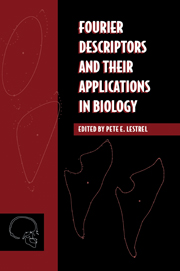Book contents
- Frontmatter
- Contents
- List of contributors
- Preface
- Acknowledgments
- Part one Theoretical considerations
- Part two Applications of Fourier descriptors
- 6 Closed-form Fourier analysis: A procedure for extraction of ecological information about foraminiferal test morphology
- 7 Fourier descriptors and shape differences: Studies on the upper vertebral column of the mouse
- 8 Application of the Fourier method on genetic studies of dentofacial morphology
- 9 Fourier analysis of size and shape changes in the Japanese skull
- 10 Craniofacial variability in the hominoidea
- 11 Heuristic adequacy of Fourier descriptors: Methodologic aspects and applications in Morphological
- 12 Analyzing human gait with Fourier descriptors
- 13 Elliptic Fourier descriptors of cell and nuclear shapes
- 14 Cranial base changes in shunt-treated hydrocephalics: Fourier descriptors
- 15 A numerical and visual approach for measuring the effects of functional appliance therapy: Fourier descriptors
- 16 Size and shape of the rabbit orbit: 3-D Fourier descriptors
- 17 From optical to computational Fourier transforms: The natural history of an investigation of the cancellous structure of bone
- 18 Epilogue: Fourier methods and shape analysis
- Appendix
- Glossary
- Index
6 - Closed-form Fourier analysis: A procedure for extraction of ecological information about foraminiferal test morphology
Published online by Cambridge University Press: 14 September 2009
- Frontmatter
- Contents
- List of contributors
- Preface
- Acknowledgments
- Part one Theoretical considerations
- Part two Applications of Fourier descriptors
- 6 Closed-form Fourier analysis: A procedure for extraction of ecological information about foraminiferal test morphology
- 7 Fourier descriptors and shape differences: Studies on the upper vertebral column of the mouse
- 8 Application of the Fourier method on genetic studies of dentofacial morphology
- 9 Fourier analysis of size and shape changes in the Japanese skull
- 10 Craniofacial variability in the hominoidea
- 11 Heuristic adequacy of Fourier descriptors: Methodologic aspects and applications in Morphological
- 12 Analyzing human gait with Fourier descriptors
- 13 Elliptic Fourier descriptors of cell and nuclear shapes
- 14 Cranial base changes in shunt-treated hydrocephalics: Fourier descriptors
- 15 A numerical and visual approach for measuring the effects of functional appliance therapy: Fourier descriptors
- 16 Size and shape of the rabbit orbit: 3-D Fourier descriptors
- 17 From optical to computational Fourier transforms: The natural history of an investigation of the cancellous structure of bone
- 18 Epilogue: Fourier methods and shape analysis
- Appendix
- Glossary
- Index
Summary
Introduction
The wide range of morphologies seen among taxa, as well as intraspecific variability, when combined with the diversity of information carried by morphology, ensures that no “one size fits all” method exists for morphologic characterization. In some cases, interest resides in determining how a single species' form has changed in response to environmental parameters; the organism being used solely as a proxy indicator. In other cases, shape components linked to such environmental factors will be excluded in order to determine the nature and rates of change of the genome as reflected in morphology. In still other cases, the morphology may be of interest in terms of some sort of functional efficiency with respect to locomotion or musculature.
A task of the investigator is to choose the best procedure for the particular experimental situation. Paramount in any investigation is choosing the optimum method to define statistically significant morphological changes. Forms that depart from classic Euclidean (geometric) regularity commonly can generate a large number of numeric descriptors. Usually, for any given research objective, only a subset of such variables are applicable. Relevant descriptors are termed “features,” and feature selection is a critical first step in any morphological analysis. Features may be known a priori on the basis of prior research on the taxon or by analogy with related taxa.
- Type
- Chapter
- Information
- Fourier Descriptors and their Applications in Biology , pp. 129 - 156Publisher: Cambridge University PressPrint publication year: 1997
- 1
- Cited by



